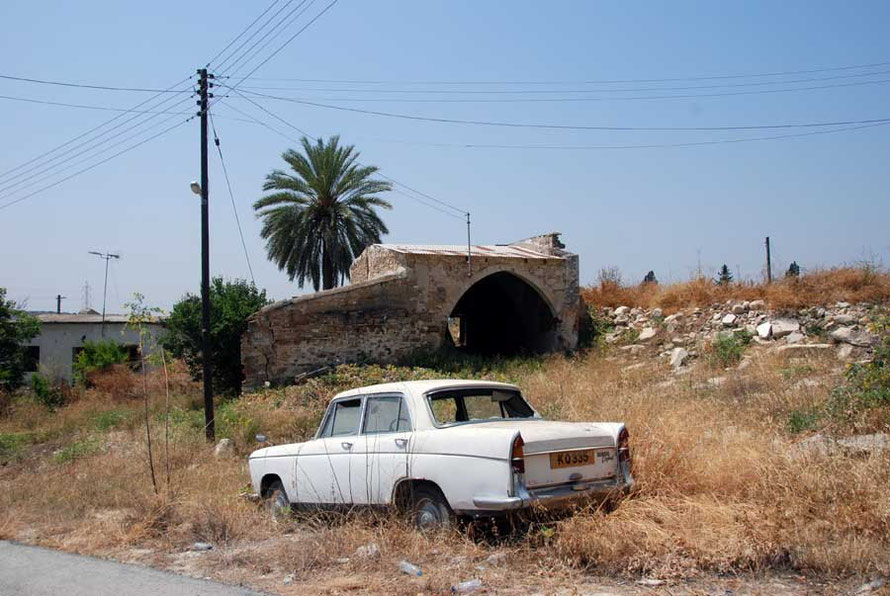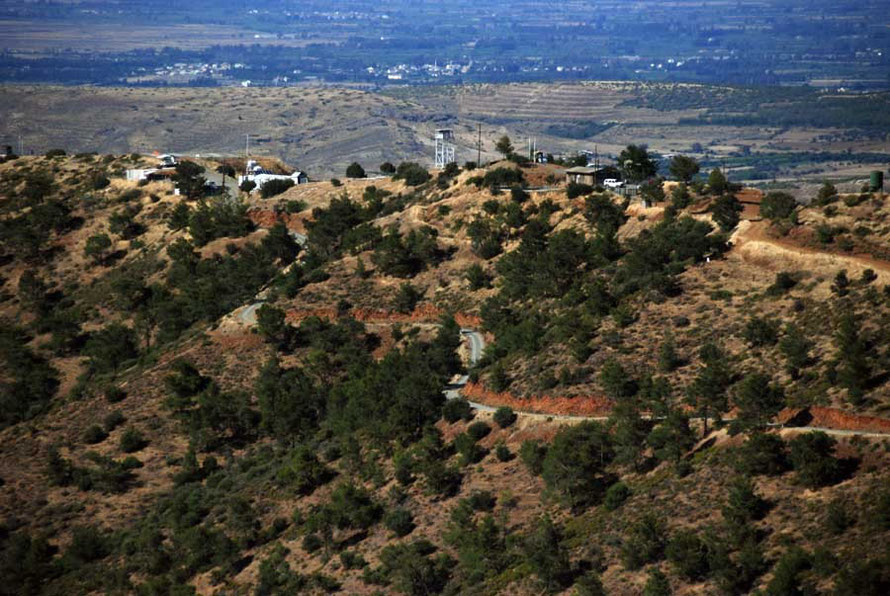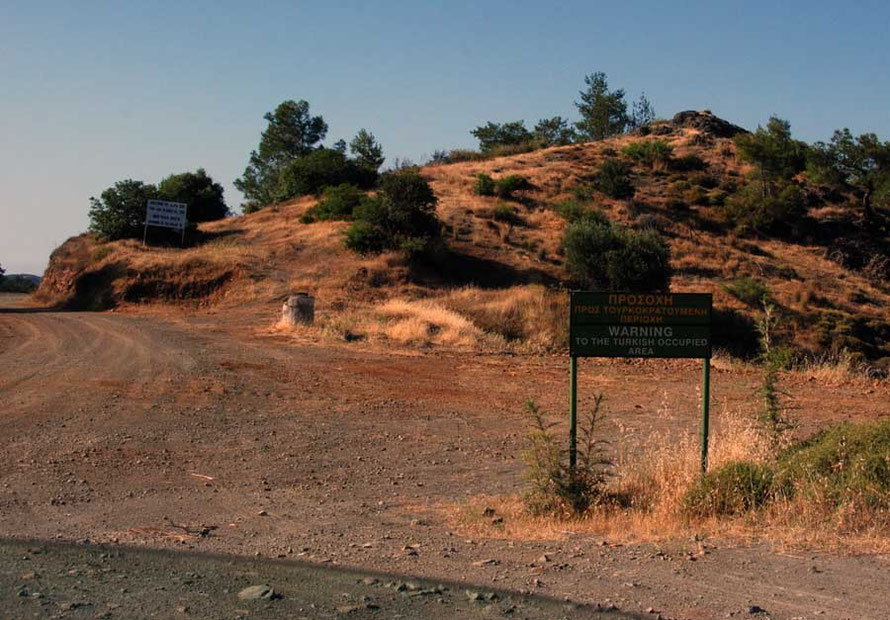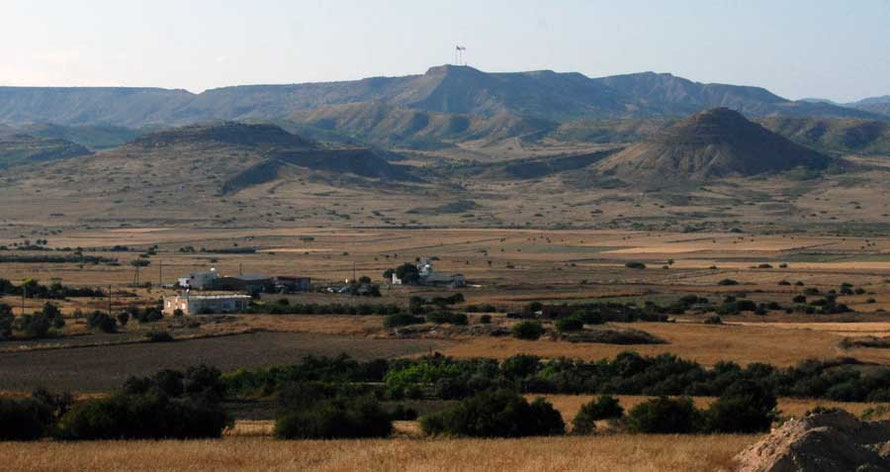Cyprus Critical Issues I. De Facto Partition and the Green Line
Introduction
The current de facto partition of the island between the Greek Cypriot Republic of Cyprus in the South and a nominally independent and internationally shunned Turkish Republic of Northern Cyprus remains unresolved. The recent (2012) death of Rauf Denktash, the dominant leader of breakaway Northern Cyprus, aged 87, marks the closing of a particular chapter in the conflict. (See this excellent obituary and summary of where things stand in the Financial Times).
The island remains horribly divided with a considerable UN peace-keeping presence and limited interchange between the two communities.
The trauma of violent partition remains and is evident to see for those who can be bothered to look. At the same time the UK maintains its possession of two sovereign bases on the island, home to 3,500 British Forces Cyprus personnel.

The population of Cyprus is about 1 million. This can be broken down into 650,000 Greek Cypriots and sizeable poulations of British and Russian residents plus Arabs, Pakastanis, Bangladeshis, Egyptians, Lebanses, Iranians, Sri Lankans, Vietnamese and Phillipinzs.
In the north there are estimated to be 200,000 permanent residents, of whom 80-90,000 hold Cyprus Republic identity cards. There are estimated to be 50,000 Turkish residents from the mainland. Then there are 100,000 short-term residents - of whom 30,000 are students. Plus there is a garrison of 30,000 Turkish troops. Foreign Affairs Select Committee Visit to Turkey and Cyprus, 2007.

The extent of the trauma from invasion, inter-ethnic violence and partition in Cyprus is considerable: 40% of both communities having been made displaced persons and another 5% having suffered as relations of killed or missing persons. (Palley, 2010 op cit. p.35.)
The traumatic events of 1974 and their aftermath saw the massive forced movement and dislocation of both communities. It is estimated that 180,000 Greek Cypriots were expelled from the north and 40,000 Turkish Cypriots were forced to flee from the south (Rough Guide pp, 79-81).
I have written up the story of the once mixed village of Peristerona in Nicosia district on a separate page here.
The island remains highly militarised. There are 12,500 National Guards 'with a substantial mainland Greek component' and 60,000 reservists in the south.
In the north there are estimated to be between 21,000 and 24,000 Turkish troops plus 3,000 Turkish Cypriot soldiers. (House of Commons Foreign Affairs Committee Visit to Cyprus 2008-9.)
The Committee on Missing Persons in Cyprus, made up of inter-communal teams working to locate and identify the missing from the 1964 and 1974 conflicts across the island had, at April 2012, exhumed the remains of 853 individuals and identified 321 of them. 255 were Greek Cypriots and 66 Turkish Cypriots.
The Green Line
The Green Line and buffer zone that divides Cyprus runs from the Kokkina Enclave and Kato Pyrgos in the west to Famagusta in the east and is 180km long. It varies in width from 3.3 metres in central of Nicosia to over 7.4km wide and 10,000 people live or work in the zone. It is overseen by the presence of nearly 1000 lightly armed troops and police who form the United Nations Peacekeeping Force in Cyprus (UNFICYP). 278 are British. The budget for the UNFICYP in 2010 was $54.41 million.
One-third of UNFICYP’s budget is financed by the Government of Cyprus, Greece contributes $6.5 million annually and the rest is 'financed from contributions assessed on the entire membership of the United Nations, as decreed in 1993.'
Map showing UNFICYP patrolled Buffer Zone (broken lines) and British Sovereign Base Areas at Akrotiri and Dhekelia (solid lines)
The UNFICYP has been on Cyprus since 1964 when the British were unable to maintain inter-communal peace on the island. Initially 6,000 troops were sent made up of a multinational force from the UK, Canada, Sweden, Denmark, Austria, Australia, Finland and Ireland. In that time UNFICYP has suffered 178 fatalities.
Sweden, Denmark and Canada have withdrawn their troops frustrated by the stalemate in the peace process and presumably fearful that UNFICYP was becoming a permanent institution of the division of Cyprus rather than a force for a reconciliation of those divisions. New countries have joined UNFICYP - Chile, Argentina, Brazil, Slovakia and Croatia.
Operation Tosca is the the name of the UK contribution to the UNFICYP. Currently the British Contingent is 278 personnel and is not part of British Forces Cyprus but instead under the direct command of the UN.
Crossing point at Astromeritis
Since 2003 seven crossing points have been opened on the Green Line. Two of these are in central Nicosia (Ledra Street and Ledra Palace), the main car crossing point is in a west Nicosia suburb, Agios Dometios, two are in the British Sovereign Base Area at Dhekelia, and one is at Astromeritis midway between Nicosia and Katos Pyrgos. The last to open is the crossing at Limnitis, near Katos Pyrgos. This opened in October 2010 and will cut the driving time from Katos Pyrgos to Nicosia from three hours to one hour.
Four villages, Pyla, Athienou, Troulloi and Deneia are located in the Buffer Zone. Pyla is the only village in Cyprus still inhabited by both its original Greek Cypriot and Turkish Cypriot inhabitants - 850 of the inhabitants are Greek Cypriots and 487 are Turkish Cypriots.
UNFICYP post in Buffer Zone near Xeros Valley (between dashed lines).
In 2011 the UN announced the end of its de-mining programme in Cyprus, having cleared 27,000 mines from the buffer zone in the previous six years. This work has been carried out by de-miners from Mozambique and Zimbabwe, along with G4S Ordnance Management, a private company. One Mozambican team leader, Felisberto Novele, lost his life in a cleared minefield 10 kilometres from Nicosia.
The UN Mine Action Centre in Cyprus (UNMACC) estimates there may be 15,000 mines remaining in Cyprus. Work has come to a halt due to a lack of access to remaining minefields outside the buffer zone. The minefield I drove past was presumably one of these.
The military side of the UNFICYP operation is divided into three sectors. Sector One covers the west of the Green Line:
Sector One Headquarters and Command Company are located in San Martin Camp, which is near Skouriotissa village. Support Company finds its home at Roca Camp, near Xeros in the north. The two line companies are deployed along four permanently manned patrol bases while also conducting mobile patrols from San Martin and Roca camps.

Towards a solution?
Tony Barber, the FT’s European editor, raises an intriguing question in the FT of 19 February 2013. He argues that the present economic crisis in the Republic of Cyprus may offer an opportunity to solve the island’s divisions (see De Facto partition).
He writes,
Cyprus’ emergency offer European leaders the best chance in almost 40 years to overcome the island’s division. … Europe’s leaders have a chance to tell the Greek Cypriots, in a friendly but firm way, that financial aid requires progress on a diplomatic settlement.

The argument behind Barber’s assertion goes firstly, Cyprus’s financial and banking crisis gives the EU and IMF considerable leverage over the Cypriot government; secondly, that the elections in progress that have placed presidential candidate and pro-UN Annan unification Plan advocate, Nicos Anastasiades, as the frontrunner in next Sunday’s second round run-off, and thirdly that within five years the communist AKEL party may be back in power – having benefitted from the unpopularity of foreign imposed austerity that its government of Demetris Christofias fostered through its incompetence – and the substantial finds of natural gas in the Levant Basin will then have started to flow, guaranteeing the financial autonomy of Greek Cypriot Cyprus.
![Entrance to a UNFICYP post on the Green Line. The sign reads, 'Welcome to Alfa Co[mpan]y. You are in Area 40. You need track free in Channel 16 to Oscar 18](https://image.jimcdn.com/app/cms/image/transf/dimension=890x10000:format=jpg/path/s43f928e84fd05874/image/ib9ad04a78ec467ec/version/1413203069/entrance-to-a-unficyp-post-on-the-green-line-the-sign-reads-welcome-to-alfa-co-mpan-y-you-are-in-area-40-you-need-track-free-in-channel-16-to-oscar-18.jpg)
The details of the bailout are still being worked out and different alternatives to the solution of the bank and sovereign debt crisis have been put forward. These consist of basically giving a haircut to bondholders (i.e. imposing losses) – which goes against the EU promise that this solution in Greece was a one-off event and would worsen the position of Cyprus’ troubled banks (as they are major holders of sovereign debt) – or to impose some kind of penalty on deposit holders – particularly on the ‘dodgy oligarchs’ with their massive Cyprus bank holdings (see the Russian Connection).
In effect the bailout raises issues about the sustainability of Cyprus’ very successful growth model of residential tourism and off-shore banking centre (some figures suggests Cyprus’s financial sector expanded by 240 per cent between 1995 and 2011 see FT 11.02.13). There is considerable EU unhappiness with Cyprus’s level of corporate tax (10%) and the adequacy of its money-laundering supervision. Without the tax incentives the Russian money will go elsewhere and a property correction could scare off new tourists.
Barber believes that the outlines of a diplomatic settlement between North and South are clear:
A two-zone federal state with a common citizenship , and compromises on territorial and property disputes. (On property issues see Peristerona.)
It will be interesting to see if this putative opportunity is recognized, let alone seized, by the new government and its EU partners.
In 2014 peace talks in Cyprus resumed. In October 2014 the talks were suspended. It is hoped both sides can be brought back to the table by the UN Special Adviser, Espen Barth Eide.




